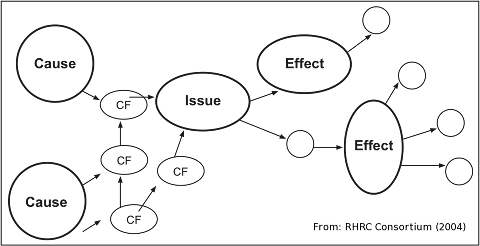Exploring Root Causes: Problem Tree and Causal Flow Analysis
- Objective: To visually analyze the underlying causes of gender inequity or a specific problem identified within communities. CARE’s Social Analysis and Action manual outlines how they have used problem tree analysis on health, though the tool may be used to discuss other arenas as well.
- Materials/Preparation: Flipchart paper, colored pens or markers.
- Participants: This can be done with CARE staff and partners, or within communities. The Social Analysis and Action Tool recommends 5-10 people per group for this exercise.
Problem Tree Analysis: Steps
To explore the roots of the problem, the group draws and writes root causes on a flipchart. Around each idea, participants discussed and reflected on why and how the idea was a cause of the problem.
Focusing on a social cause of the problem (i.e. traditions), the facilitator starts a new flipchart to unpack its root causes, repeating the same exercise to dig deeper and unpack existing socio-cultural factors.
Finally, based on these factors, the group explores ways to overcome some of the causes they have identified.
Variation: Causal Flow Analysis or "Spider Diagram" Analysis
Following introductions, the facilitator asked participants to think about the causes and effects of a certain issue (i.e. violence against women and girls).
On flipchart or the idea card, the facilitator writes the name of the main issue (i.e. sexual violence).
The facilitator asks participants to discuss the causes of the issue. The factors given are written on cards or flip-chart on the left-hand side of the main issue, with arrows drawn from causes to their effect.
-
- Probe→ Are there any root causes that seem more important than others? Which ones? Why?
- Probe→ Are there any that are surprising to you? Which/Why?
- Probe→ What are the similarities and differences of the impact of violence on male youth and female youth?
Once causes have been thoroughly discussed, the facilitator then asks about the effects of the problem. The factors given are written on cards or flip-chart on the right=hand side of the main issue, with arrows drawn from the issue to their direct effects.

Based on the diagram, the facilitator led a discussion to probe deeper into participants’ understanding of the issue – its causes, contributing factors and effect? How do each factor relate to one another and why? What are ways to overcome key causes?
Variation: Dream Trees
In an exercise with girls and boys, to understand their aspirations, and barriers that face them, this exercise asks girls (or boys) to first draw trees.
At the roots, participants draw what values or drivers support them to make them successful.
At the trunk, participants draw what barriers they face at the moment.
At the leaves and flowers, children draw in their hopes and dreams for the future.
Once drawn, the facilitator engages a discussion to probe into the root supporting factors, barriers and aspirations of girls and boys. In discussions, the facilitator may also want to probe into what opportunities exist to overcome the barriers presented. This can be done in a group or individually.
Resources
- CARE (2007). Ideas and Action: Addressing the Social Factors that Influence Sexual and Reproductive Health.
- CARE and ICRW (2007). PLA Field Guide: Western Balkans Gender-Based Violence Initiative. Exploring Dimensions of Masculinity and Violence with Young Men: Skills Building Workshop at Investing in Young People’s Health and Development: Research that Improves Policies and Programs.
- Patsy Collins Trust Fund Initiative (2006). Selected Participatory Techniques for Situational Analysis. LEADER Workshop. CARE International - Tanzania.
- RHRC Consortium (2004). Gender-based Violence Tools Manual: For Assessment, Program Design, Monitoring and Evaluation in Conflict-Affected Settings.
- P Stephenson with S Gourley and G Miles (2004). Resourcing Organisations with Opportunities for Transformation and Sharing 7: Child Participation. Teddington: Tearfund.
- D VanBelle-Prouty and H Sey (1998). Girls' Participatory Learning Activities in the Classroom Environment (GirlsPLACE) A View to the Experiences of Girls. Institute for International Research.
